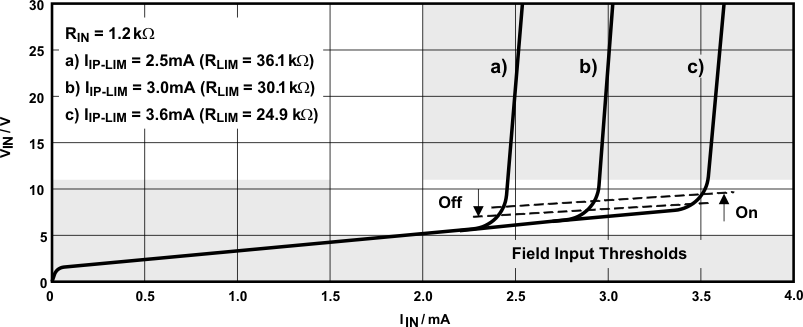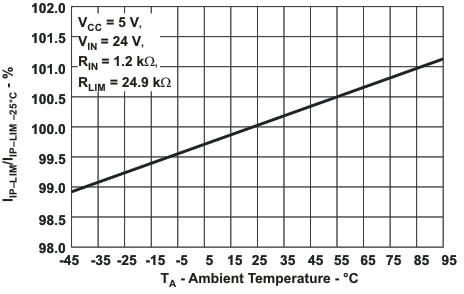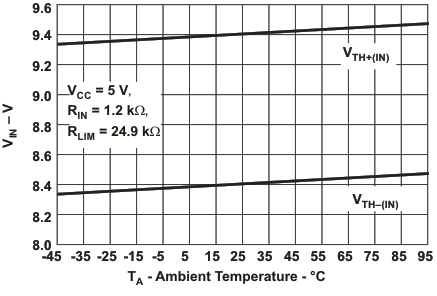SLAS638A January 2009 – October 2015 SN65HVS885
PRODUCTION DATA.
- 1 Features
- 2 Applications
- 3 Description
- 4 Revision History
- 5 Pin Configuration and Functions
- 6 Specifications
- 7 Parameter Measurement Information
- 8 Detailed Description
- 9 Application and Implementation
- 10Power Supply Recommendations
- 11Layout
- 12Device and Documentation Support
- 13Mechanical, Packaging, and Orderable Information
6 Specifications
6.1 Absolute Maximum Ratings
over operating free-air temperature range (unless otherwise noted) (1)| MIN | MAX | UNIT | ||||
|---|---|---|---|---|---|---|
| VCC | Device power input | VCC | –0.5 | 6 | V | |
| VIPx | Field digital inputs | IPx | –0.3 | 36 | V | |
| VID | Voltage at any logic input | DB0, DB1, CLK, SIP, CE, LD | –0.5 | 6 | V | |
| IO | Output current | HOT, SOP | –8 | 8 | mA | |
| PTOT | Continuous total power dissipation | See Thermal Information | ||||
| TJ | Junction temperature | 170 | °C | |||
| Tstg | Storage temperature | 150 | °C | |||
(1) Stresses beyond those listed under "absolute maximum ratings" may cause permanent damage to the device. These are stress ratings only, and functional operation of the device at these or any other conditions beyond those indicated under "recommended operating conditions" is not implied. Exposure to absolute-maximum-rated conditions for extended periods may affect device reliability.
6.2 ESD Ratings
| VALUE | UNIT | ||||
|---|---|---|---|---|---|
| V(ESD) | Electrostatic discharge | Human body model (HBM), per ANSI/ESDA/JEDEC JS-001(1) | All pins | ±4000 | V |
| IPx | ±15000 | ||||
| Charged-device model (CDM), per JEDEC specification JESD22-C101(2) | ±1000 | ||||
| Machine model (MM)(3) | ±100 | ||||
(1) JEDEC document JEP155 states that 500-V HBM allows safe manufacturing with a standard ESD control process.
(2) JEDEC document JEP157 states that 250-V CDM allows safe manufacturing with a standard ESD control process.
(3) JEDEC Standard 22, Method A115-A
6.3 Recommended Operating Conditions
| MIN | NOM | MAX | UNIT | ||
|---|---|---|---|---|---|
| VCC | Device supply voltage | 4.5 | 5 | 5.5 | V |
| VIPL | Field input low-state input voltage | 0 | 4 | V | |
| VIPH | Field input high-state input voltage | 5.5 | 34 | V | |
| VIL | Logic low-state input voltage | 0 | 0.8 | V | |
| VIH | Logic high-state input voltage | 2.0 | 5.5 | V | |
| RLIM | Current limiter resistor | 17 | 25 | 500 | kΩ |
| fIP (1) | Input data rate | 0 | 1 | Mbps | |
| TA | Device | –40 | 125 | °C | |
| TJ | Junction Temperature | 150 | °C | ||
(1) Maximum data rate corresponds to 0 ms debounce time, (DB0 = open, DB1 = GND), and RIN = 0 Ω
6.4 Thermal Information
| THERMAL METRIC(1) | SN65HVS885 | UNIT | |||
|---|---|---|---|---|---|
| PWP (HTSSOP) | |||||
| 28 PINS | |||||
| RθJA | Junction-to-ambient thermal resistance | High-K thermal resistance | 35 | °C/W | |
| RθJC(top) | Junction-to-case (top) thermal resistance | 4.27 | °C/W | ||
| RθJB | Junction-to-board thermal resistance | 15 | °C/W | ||
| ψJT | Junction-to-top characterization parameter | 0.6 | °C/W | ||
| ψJB | Junction-to-board characterization parameter | 15.9 | °C/W | ||
| RθJC(bot) | Junction-to-case (bottom) thermal resistance | 2.4 | °C/W | ||
(1) For more information about traditional and new thermal metrics, see the Semiconductor and IC Package Thermal Metrics application report, SPRA953.
6.5 Electrical Characteristics
over full-range of recommended operating conditions (unless otherwise noted) all voltages measured against device ground, see Figure 9| PARAMETER | TERMINAL | TEST CONDITIONS | MIN | TYP | MAX | UNIT | ||
|---|---|---|---|---|---|---|---|---|
| FIELD INPUTS | ||||||||
| VTH–(IP) | Low-level device input threshold voltage | IP0–IP7 | RLIM = 25 kΩ | 4 | 4.3 | V | ||
| VTH+(IP) | High-level device input threshold voltage | 5.2 | 5.5 | V | ||||
| VHYS(IP) | Device input hysteresis | 0.9 | V | |||||
| VTH–(IN) | Low-level field input threshold voltage | Measured at field side of RIN |
4.5 V < VCC < 5.5 V, RIN = 1.2 kΩ ± 5%, RLIM = 25 kΩ, TA ≤ 125°C |
6 | 8.4 | V | ||
| VTH+(IN) | High-level field input threshold voltage | 9.4 | 10 | V | ||||
| VHYS(IN) | Field input hysteresis | 1 | V | |||||
| RIP | Input resistance | IP0–IP7 | 3 V < VIPx < 6 V, RLIM = 25 kΩ |
0.2 | 0.63 | 1.1 | kΩ | |
| IIP-LIM | Input current limit | IP0–IP7 | RLIM = 25 kΩ | 3.15 | 3.6 | 4 | mA | |
| tDB | Debounce times of input channels | IP0–IP7 | DB0 = open, DB1 = GND | 0 | ms | |||
| DB0 = GND, DB1 = open | 1 | |||||||
| DB0 = DB1 = open | 3 | |||||||
| IRE-on | RE on-state current | RE0–RE7 | RLIM = 25 kΩ, REX = GND | 2.8 | 3.15 | 3.5 | mA | |
| DEVICE SUPPLY | ||||||||
| ICC(VCC) | Supply current | VCC | IP0 to IP7 = 24V, REX = GND, All logic inputs open |
6.5 | 10 | mA | ||
| LOGIC INPUTS AND OUTPUTS | ||||||||
| VOL | Logic low-level output voltage | SOP, HOT | IOL = 20 μA | 0.4 | V | |||
| VOH | Logic high-level output voltage | IOH = –20 μA | 4 | V | ||||
| IIL | Logic input leakage current | DB0, DB1, SIP, LD, CE, CLK |
–50 | 50 | μA | |||
| TOVER | Over-temperature indication | 150 | °C | |||||
| TSHDN | Shutdown temperature | 170 | °C | |||||
| POWER DISSIPATION | ||||||||
| PD | Power Dissipation | VCC = 5 V, RIN = 0Ω, RLIM = 25 kΩ, RE0 – RE7 = GND, fCLK = 100 MHz |
IP0-IP7 = 34 V | 1100 | mW | |||
| IP0-IP7 = 24 V | ||||||||
| IP0-IP7 = 20 V | ||||||||
| IP0-IP7 = 12 V | ||||||||
6.6 Timing Requirements
over operating free-air temperature range (unless otherwise noted)| MIN | NOM | MAX | UNIT | |||
|---|---|---|---|---|---|---|
| tW1 | CLK pulse width | See Figure 6 | 4 | ns | ||
| tW2 | LD pulse width | See Figure 4 | 6 | ns | ||
| tSU1 | SIP to CLK setup time | See Figure 7 | 4 | ns | ||
| tH1 | SIP to CLK hold time | See Figure 7 | 2 | ns | ||
| tSU2 | Falling edge to rising edge (CE to CLK) setup time | See Figure 8 | 4 | ns | ||
| tREC | LD to CLK recovery time | See Figure 5 | 2 | ns | ||
| fCLK | Clock pulse frequency | See Figure 6 | DC | 100 | MHz | |
6.7 Switching Characteristics
over operating free-air temperature range (unless otherwise noted)| PARAMETER | TEST CONDITIONS | MIN | TYP | MAX | UNIT | |
|---|---|---|---|---|---|---|
| tPLH1, tPHL1 | CLK to SOP | CL = 15 pF, see Figure 6 | 10 | ns | ||
| tPLH2, tPHL2 | LD to SOP | CL = 15 pF, see Figure 4 | 14 | ns | ||
| tr, tf | Rise and fall times | CL = 15 pF, see Figure 6 | 6 | ns | ||
6.8 Typical Characteristics
 Figure 1. Typical Input Characteristics
Figure 1. Typical Input Characteristics
 Figure 2. Typical Current Limiter Variation vs Ambient Temperature
Figure 2. Typical Current Limiter Variation vs Ambient Temperature
 Figure 3. Typical Limiter Threshold Voltage Variation vs Ambient Temperature
Figure 3. Typical Limiter Threshold Voltage Variation vs Ambient Temperature